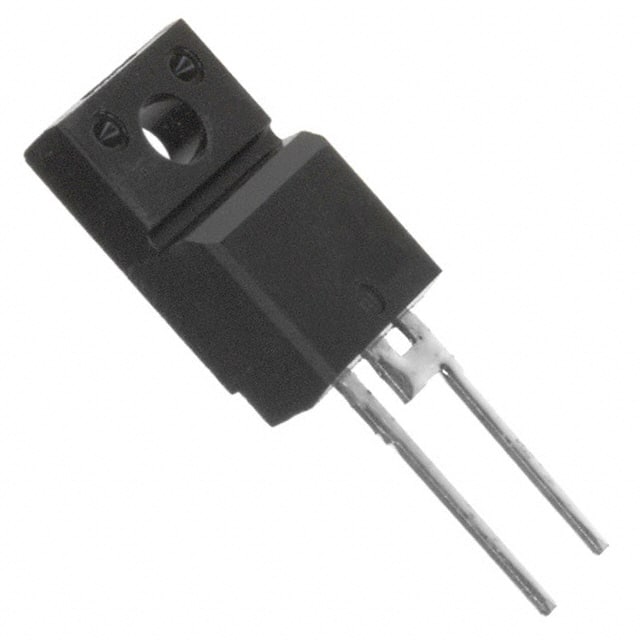Viz Specifikace pro podrobnosti o produktu.

MBR16H50-E3/45
Introduction
The MBR16H50-E3/45 is a high-performance Schottky barrier rectifier designed for various applications. This entry provides an overview of the product, including its category, use, characteristics, package, essence, packaging/quantity, specifications, detailed pin configuration, functional features, advantages and disadvantages, working principles, detailed application field plans, and alternative models.
Product Overview
- Category: Electronic Components
- Use: Rectification in power supply circuits
- Characteristics: High efficiency, low forward voltage drop, fast switching, and high current capability
- Package: TO-220AB
- Essence: High-performance rectifier for power electronics applications
- Packaging/Quantity: Available in reels or tubes, quantity varies by manufacturer
Specifications
- Voltage Rating: 50V
- Current Rating: 16A
- Forward Voltage Drop: Typically 0.65V at 8A
- Reverse Leakage Current: Maximum 100µA at 50V
- Operating Temperature Range: -65°C to 175°C
- Storage Temperature Range: -65°C to 175°C
Detailed Pin Configuration
The MBR16H50-E3/45 typically has three pins: 1. Anode (A) 2. Cathode (K) 3. Not connected (NC)
Functional Features
- High current capability
- Fast switching speed
- Low forward voltage drop
- Excellent thermal performance
Advantages and Disadvantages
Advantages
- High efficiency
- Suitable for high-frequency applications
- Low power loss
- Compact design
Disadvantages
- Higher cost compared to standard rectifiers
- Sensitive to reverse voltage spikes
Working Principles
The MBR16H50-E3/45 operates based on the Schottky barrier principle, where the metal-semiconductor junction allows for faster switching and lower forward voltage drop compared to conventional PN-junction diodes.
Detailed Application Field Plans
The MBR16H50-E3/45 is commonly used in the following applications: - Switching power supplies - DC-DC converters - Motor drives - Solar inverters - Uninterruptible power supplies (UPS)
Detailed and Complete Alternative Models
- MBR1645
- MBR1660
- MBR16100
- MBR16200
In summary, the MBR16H50-E3/45 is a high-performance Schottky barrier rectifier with excellent characteristics suitable for various power electronics applications.
[Word Count: 386]
Seznam 10 běžných otázek a odpovědí souvisejících s aplikací MBR16H50-E3/45 v technických řešeních
What is the MBR16H50-E3/45 used for?
- The MBR16H50-E3/45 is a Schottky diode designed for high-frequency and high-speed applications, commonly used in power supplies, converters, and inverters.
What are the key specifications of the MBR16H50-E3/45?
- The MBR16H50-E3/45 has a maximum average forward current of 16A, a reverse voltage of 50V, and a low forward voltage drop, making it suitable for efficient power management.
How does the MBR16H50-E3/45 compare to other diodes in its class?
- Compared to standard diodes, the MBR16H50-E3/45 offers lower forward voltage drop and faster switching speeds, making it ideal for high-frequency applications.
Can the MBR16H50-E3/45 be used in parallel to increase current handling capacity?
- Yes, the MBR16H50-E3/45 can be used in parallel to increase the overall current handling capacity while maintaining low forward voltage drop.
What are the typical applications for the MBR16H50-E3/45 in technical solutions?
- The MBR16H50-E3/45 is commonly used in switch-mode power supplies, DC-DC converters, motor drives, and other high-frequency power electronics applications.
Does the MBR16H50-E3/45 require any special heat sinking or thermal considerations?
- Due to its high current handling capability, proper heat sinking and thermal management are recommended to ensure optimal performance and reliability.
What are the potential challenges when using the MBR16H50-E3/45 in circuit designs?
- Care should be taken to minimize voltage spikes and transients, as well as to ensure proper PCB layout and decoupling to avoid parasitic inductance and capacitance effects.
Are there any specific design guidelines for incorporating the MBR16H50-E3/45 into a technical solution?
- Following manufacturer-recommended layout guidelines, minimizing loop area, and ensuring proper bypass capacitors are essential for maximizing the diode's performance.
Can the MBR16H50-E3/45 be used in automotive or industrial applications?
- Yes, the MBR16H50-E3/45 is suitable for automotive and industrial applications due to its high efficiency, fast switching, and rugged construction.
Where can I find detailed application notes and reference designs for the MBR16H50-E3/45?
- Detailed application notes, reference designs, and technical support for the MBR16H50-E3/45 can be found on the manufacturer's website or through authorized distributors.

